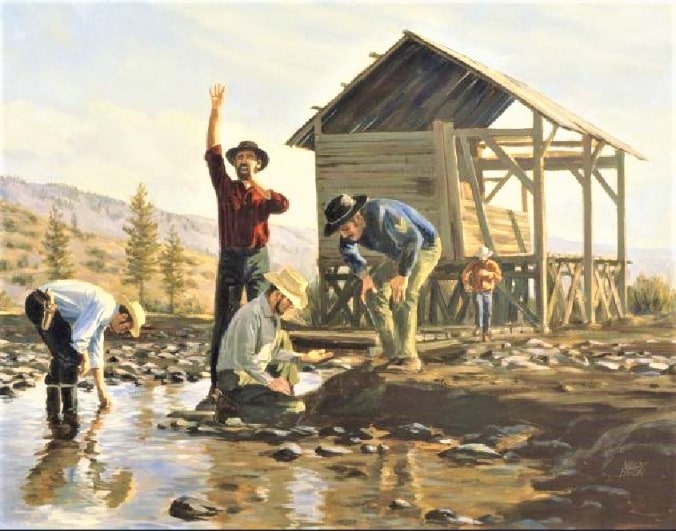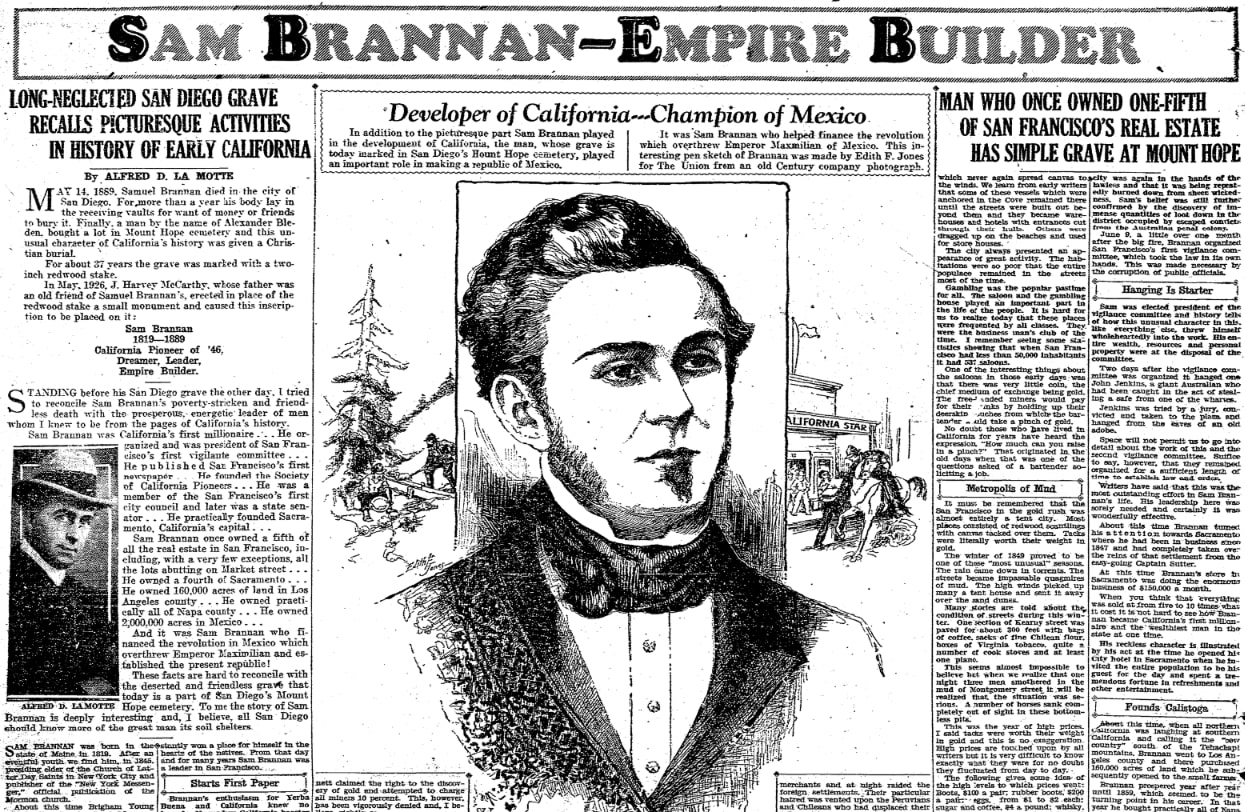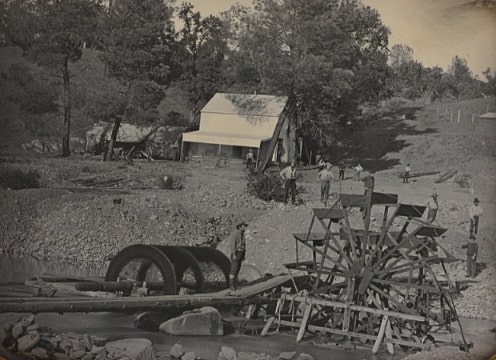Introduction: In this article, Melissa Davenport Berry continues her story about the California Gold Rush, focusing on John Sutter. Melissa is a genealogist who has a website, americana-archives.com, and a Facebook group, New England Family Genealogy and History.
Today I continue with my story about the California Gold Rush (1848-1855), a mania which incited over 300,00 persons to make the journey to seek their fortune in gold (known as the “49ers” because 1849 was the peak year for arrivals).

To recap: James Wilson Marshall discovered gold on 24 January 1848 in the South Fork of the American River, in the foothills of the Sierra Nevada Mountains, while erecting Captain John Sutter’s Mill in Coloma, California. His boss tried to contain the treasure trove strike.
Mormon elder Samuel Brannan, who ran a local mercantile store nearby, was tipped off on the discovery and could not keep quiet. Brannan, owner of the California Star newspaper in San Francisco, helped leak the story.
The military governor of the district, Colonel Richard Barnes Mason, along with his aide Lt. William Tecumseh Sherman, made a trip up the river to see for themselves.
Brannan saw this discovery as a golden opportunity. First, he stockpiled plenty of supplies in his store needed to go after the gilt, and any other necessities that a miner needed. Next, he visited some Mormons in the area who had made a rich strike and claimed a slice of the pie from each one – because, he said, as an elder he was supposed to collect “the Lord’s tithe.”
It was not long before his devoted flock started to question why their saint leader was skimming from their pot. When they discovered Brannan was just lining his own pockets, the drama was heightened.
Alfred D. La Motte wrote an article about Brannan’s adventures for the San Diego Union.

Here is the dish about Brannan’s tithe collecting, from La Motte’s article:
One of the men asked Colonel Mason if Brannan, as their high priest, had a legal right to take the Lord’s money from them. Mason is said to have replied that he most certainly did have that authority as long as they were fools enough to pay.
Sam’s tithe collections ceased after that, but it was by no means the end of the matter. Somehow the information about the Lord’s money reached the ears of [Mormon leader] Brigham Young in Salt Lake, and he promptly dispatched an apostle to Sam with the request that the Lord’s money be turned over to him. Brannan told the apostle: “Go back and tell Brigham that when he presents me with a receipt, signed by the Lord in person, I will gladly turn over the money.”
The Mormon history tells us that about this time Sam Brannan was dropped from the church.
Brannan had a get-rich scheme that didn’t rely on tithes: help spread the word and start a gold rush that would drive more and more eager prospectors into the area – all needing supplies from his store. La Motte called Brannan the Pied Piper of gold and wrote in his article:
…Brannan landed in Yerba Beuna cove [San Francisco] and rushed to Portsmouth Square where he shouted in his great voice, “Gold, gold, gold from the south fork of the American River!” And held over his shaggy head a flask filled with nuggets of gold.
Meanwhile Colonel Mason and Lt. Sherman sent a message to the president with 230 ounces of California gold to confirm the rumors.
The report prompted President Polk to make an announcement of the gold strike in his State of the Union message to Congress on 5 December 1848. This official confirmation of the news triggered a mass exodus to California the next year. The “Forty-Niners” were on their way.
In 1935 an article was published in the Carbon County News with more information about the gold discovery, citing diary entries.
The article reported how this gold discovery caused the downfall of Captain Sutter’s settlement, which he had named “New Helvetia” after his homeland in Switzerland. He had dreamed of having an agricultural empire in the Sierra Nevada foothills, but instead the area became overrun with gold prospectors.
New Helvetia was ruined. Before its decline, however, it had hosted many notables such as Col. John C. Freemont, Kit Carson, Gen. Stephen Kearney, and Joseph Warren Revere, the grandson of Paul Revere, “who inherited some of his ancestor’s talent for drawing and who made the sketch of the fort [shown in the above article].”
Sutter’s diary entries shortly before the gold was discovered recorded that, in August of 1847, “a host of Mormons here to buy provisions and have blacksmith work done.” Also, “Made a contract with James Wilson Marshall for a sawmill to be erected on the American Fork [the South Fork of the American River].”
A diary entry from the next day remarked on many more Mormons coming to have horses shod, and Sutter “employed nearly all of them to work here since they seem uniformly honest, honorable, and hard working.”
Marshall, along with Peter Wimmer, found a good location for the mill site. They began construction and later made the gold discovery, an event Sutter wanted kept quiet.
Enter Sam Brannan, described in Sutter’s diary as “the Mormon with a booming voice.” Here are a few added tidbits on how he got the skinny on the gold find.
It came by word of mouth, like a game of telephone. It was reported that a teamster named Jacob Wittmer, who was bringing provisions to Sutter’s Mill, was informed of the discovery of the gold from one of Peter Wimmer’s “chattering” sons who in turn slipped the news to Brannan. The rest is history.
The gold rush was indeed on! The prospect of golden riches hijacked the entire country. So much so that a warning was issued in many newspapers, such as this one published in the Vermont Gazette on 26 December 1848.
This article raised warnings about the financial risk and personal safety issues involved in the pursuit of California gold, as well as the detrimental effect the new gold would have on the gold standard, lessening its value. The article recalled how the gold mines in South America ruined Spain.
Stay tuned for more!
Explore over 330 years of newspapers and historical records in GenealogyBank. Discover your family story! Start a 7-Day Free Trial
Note on the header image: river mining for gold on the North Fork of the American River, California, ca.1853. Credit: George H. Johnson; the Nelson-Atkins Museum of Art; Wikimedia Commons.
Related Article:
